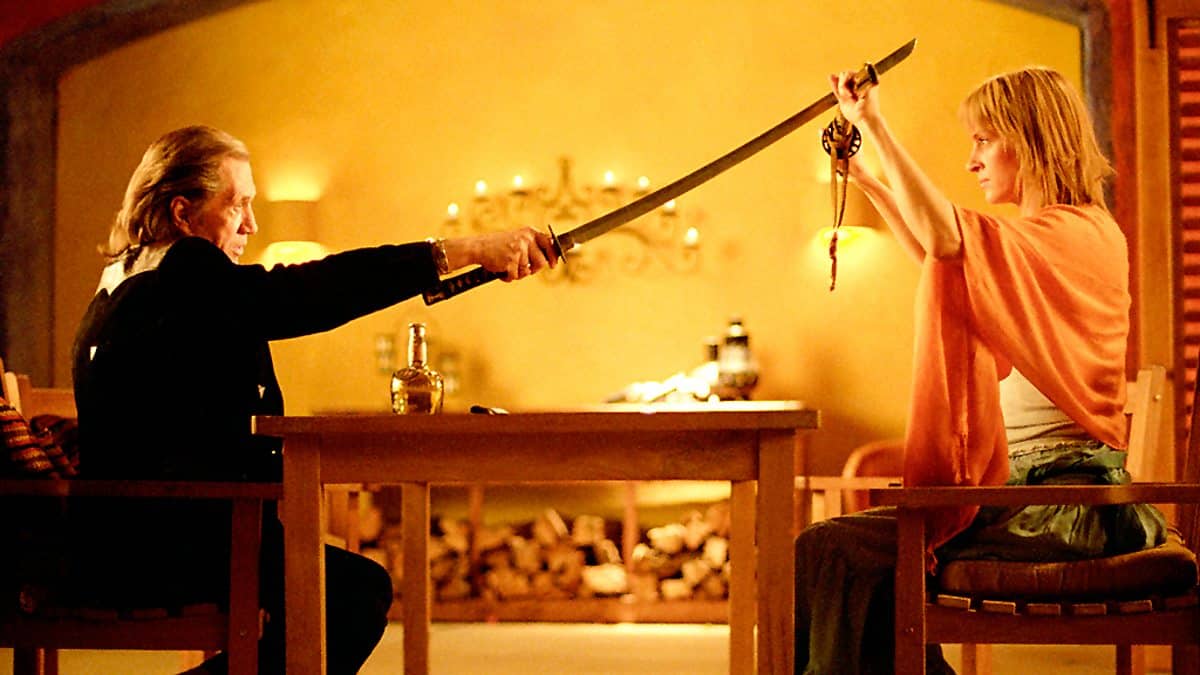Quentin Tarantino has been threatening to hang up his director’s chair after ten films for years now, but fans aren’t quite ready to say goodbye. His scrapped project, The Movie Critic, left a giant question mark hanging over what will become his final feature. Naturally, the long-rumored Kill Bill Vol. 3 seems like the logical successor. Until then, audiences are getting something else: Kill Bill: The Whole Bloody Affair, a four-hour Frankenstein of a movie you’ve technically already seen. But just not like this.
On December 5, Lionsgate will release the definitive version of Tarantino’s revenge epic, combining Vol. 1 (2003) and Vol. 2 (2004) into one uninterrupted movie, complete with an intermission and a never-before-seen seven-and-a-half-minute animated sequence. For the first time, Kill Bill: The Whole Bloody Affair will roll out projected in both 70mm and 35mm, ensuring that blood sprays and swords clash across screens the way Tarantino always wanted. “I wrote and directed it as one movie — and I’m so glad to finally give fans the chance to see it as one movie,” Tarantino said. “The best way to experience Kill Bill: The Whole Bloody Affair is in a theater, in glorious 70mm or 35mm. Blood and guts on the big screen in all their glory!”
For years, this cut has been a talked about legend among cinephiles, only popping up in special screenings like the 2011 run at Los Angeles’ New Beverly Cinema. Now, two decades later, audiences can finally experience Uma Thurman’s Bride taking her unrelenting path of vengeance without cliffhangers or recap interruptions. Gone is the split that once forced Tarantino to compromise on runtime, a decision made alongside Harvey Weinstein when the original cut ballooned to nearly four hours.

Watching both volumes together actually changes the films a bit. Vol. 1 plays like a hyper-stylized comic book come to life, while Vol. 2 slows down to deliver backstory and introspection. In isolation, they feel like different beasts; combined, they sharpen one another. The tone of Kill Bill: The Whole Bloody Affair swings from anime-inspired violence (Lucy Liu’s O-Ren Ishii backstory remains one of Tarantino’s most striking flourishes) to quiet, dialogue-heavy character moments, creating an amazing revenge epic.
The story is still very much about Thurman’s Bride. She’s betrayed, left in a coma, robbed of her unborn child, and hellbent on settling the score with Bill (David Carradine). Her bloody checklist of enemies spans the Deadly Viper Assassination Squad, including Lucy Liu, Vivica A. Fox, Michael Madsen, and Daryl Hannah. When these films first released, they pulled in $333 million worldwide. Can Kill Bill: The Whole Bloody Affair add some more dollars to that figure?
This release of Kill Bill: The Whole Bloody Affair also reignites the question about what comes next for the director. Tarantino insists he’s only made nine movies, because Kill Bill counts as one. That leaves him with one final slot, and fans are already placing bets on whether it’s actually Kill Bill Vol. 3. He’s famously coy about it, but after sharpening The Bride’s sword for four straight hours, it’s hard not to imagine her story continuing. Why else would he release Kill Bill: The Whole Bloody Affair now after so many years?

Yes, four hours of Tarantino is a lot. But if you’re going to spend half your day in a theater, it may as well be with a director who knows how to make time fly by in a whirl of katanas.
RELATED: How Bill Could’ve Survived The Five Point Palm Exploding Heart Technique In Kill Bill









Discussion about this post